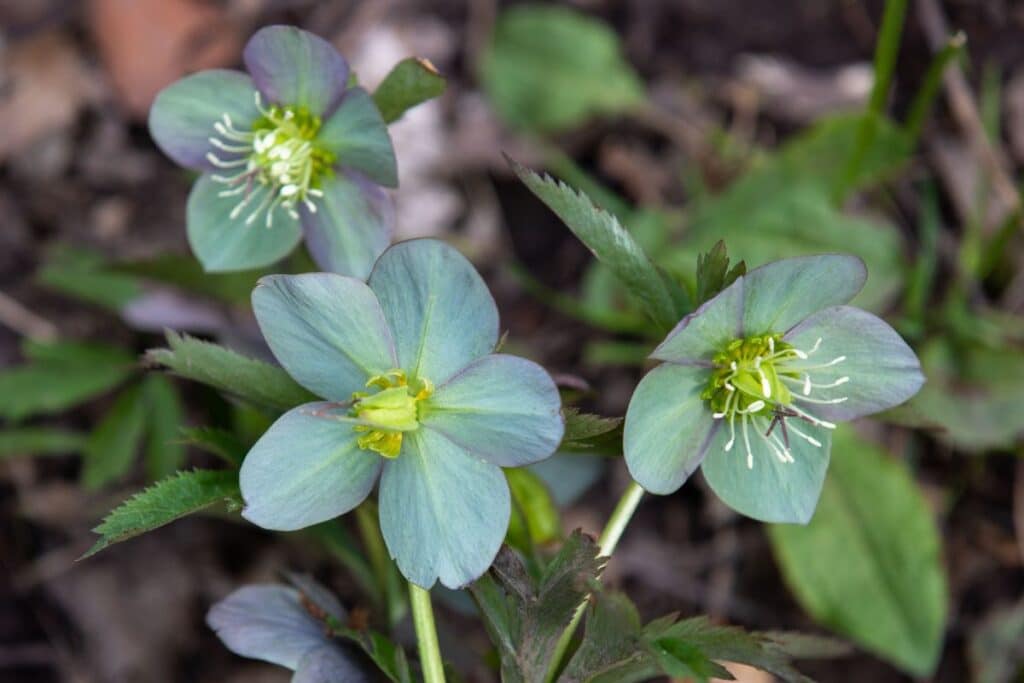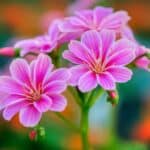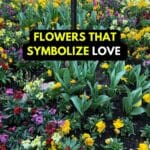If you consider yourself a budding florist, then you should know all there is to know about flowers, including their meanings and symbolism.
One of the most intriguing and mysterious blooms is the hellebore flower, also known by other common name options like Christmas rose or Lenten rose. It blooms fro late winter until the early spring, making it a great choice for a winter garden.
Most often known as the Christmas rose, it has five petal like sepals and nectar holding petals, with the plant’s nectar considered somewhat off putting (which is why it’s sometimes referred to as the “witches flying ointment!”).
A member of the buttercup family, it grows best in partial sun with an ample water supply. Most importantly, this plant has a magical history and a deep symbolism.
Let’s take a look at what this unique flower symbolizes and why it’s so popular with florists in this ultimate guide to the many species of hellebore and its symbolic meaning.
What Does Hellebore Mean? The Etymological Meaning of Hellebore
The hellebore is a plant of many names, including Christmas rose, Lenten rose, and even “stinking hellebore.” But what does it actually mean?
The word hellebore comes from two Greek words, the ancient Greek word “helios” which means sun, and the Greek word “bora” which means food or sustenance. Put together, hellebore literally translates to “sun food” or “sun sustenance.” It was likely chosen as the name of this flowering plant because it needs plenty of sunlight in order to grow and thrive.
The word itself has been around since at least 400 BCE when it was first mentioned by Hippocrates in his work On Airs, Waters, and Places. It’s a part of many ancient and modern traditions.
The genus Helleborus also contains several species that are medicinal in nature, including one variety known as black hellebore.
This type of hellebore was used medicinally by ancient Greek society to treat mental illness and other ailments such as dropsy (an old term for edema). In fact, some ancient texts suggest that this hellebore was even used as an antidote for poisons such as hemlock!
The use of medicinal plants such as hellebores has been part of human culture since prehistoric times and is still utilized today by modern herbalists around the world. Hellebore poisoning is a real risk, which is why in ancient times hellebore symbolized delirium.
It is also worth mentioning that while most varieties of hellebores are harmless when handled correctly, some contain toxins that can be dangerous if ingested or introduced directly into your bloodstream (such as through an injection). As such, great care should be taken when handling these plants in order to avoid potential harm.

What Do Hellebore Flowers Symbolize?
Have you ever seen a hellebore flower? These unique blooms are often overlooked, but they possess a great deal of symbolism.
From their storied past to the hidden meaning behind the flowers’ name, hellebore flowers have much more to them than meets the eye. In the Victorian language, many species of hellebore symbolize good fortune and holiday cheer, making it an excellent choice for the Christmas season.
The meaning varies depending on the many types of hellebore, including the stinking hellebore, the false hellebore, Helleborus niger, and Helleborus orientalis. The color of the lenten rose also plays a role.
Let’s explore the symbolism and stories associated with this remarkable bloom in terms of the Victorian language of flowers.
What Does a Green Hellebore Plant Symbolize?
The symbolism of green hellebore flowers is all about rebirth and renewal. It suggests that after a period of darkness and difficulty, something new and beautiful can emerge.
It’s also said to represent the idea that change is inevitable, so it’s important to embrace it rather than fear it.
What Does a Red Hellebore Flower Represent?
Red hellebore plants symbolizes passion and physical desire. It suggests that even when times are tough, there can still be love in the world. Red is also a very powerful color—it stands for courage and strength in the face of adversity.
So if you come across a red hellebore flower, it could be a reminder that you have the inner strength and determination to tackle any challenge life throws at you.
What is the Symbolism of a Black Hellebore Plant?
The symbolism of hellebore plants that are black is quite different from other colors of this flower—it stands for protection from negative energy and warding off bad luck or ill-will.
In folklore, black lowers were said to protect against danger and evil spirits, so if you find yourself surrounded by negativity or feeling unlucky, perhaps picking up a black flower would help turn your fortunes around!

What is the Symbolic Meaning of White Flowers?
White blooms have long been seen as symbols of innocence, purity and hope; they suggest that no matter how dark things may seem right now, brighter days are ahead.
Besides purity, the numerous flower blossoms of the white Christmas rose also represents peace and serenity—so if you need some respite from life’s struggles or want to feel more relaxed, try surrounding yourself with white flowers like white hellebore flowers!
What is the Cultural Significance of a Hellebore?
In Ancient Greece, hellebore perennial plants were thought to have magical properties in its symbolic meaning.
The ancient Greek people was believed that consuming the vibrant lime green leaves of the hellebore would bring good luck, protection, and even immortality. Its symbolic meaning almost meant that it wasthought to ward off evil spirits and protect against curses—hence why it was so popular with Ancient Greeks who were warriors!
But it’s not just the ancient Greek people who find deep flower symbolism in this mysterious plant.
In modern times, the hellebore has become a symbol of strength and joy. Its beautiful flowers have come to represent resilience in difficult situations, like dark winter days, as well as joy in celebration. Many newly married couples choose to include hellebore flowers in their wedding bouquets as a way to signify long-lasting love and commitment.
The hellebore is also associated with rebirth, regeneration, and renewal because it often blooms during times when other plants are dormant or just awakening from winter dormancy. This makes it an ideal choice for gardeners who want to add color to their landscape all year round!
The Darker Side of Hellebore
Hellebore is a poisonous flower that has been known since the Middle Ages for its toxic and medicinal properties. It is native to central Europe and has been used for centuries as a natural remedy for various ailments, including snake bites, nervous disorders, and arthritis.
In mythology, the hellebore is associated with the story of the Siege of Kirrha, which took place in ancient Greece. It is said that the soldiers of the King of Argos used hellebore to poison the water supply of their enemies, which helped them win the battle.
However, the hellebore also has a darker side, as it can cause serious health problems if ingested in large amounts. In fact, it is one of the most poisonous plants in the world. Its poisonous nature has made it a popular choice for assassination attempts throughout history, including the attempted poisoning of Alexander the Great.
In Christian symbolism, the hellebore is associated with the Nativity. According to legend, a young shepherdess named Madelon was so poor that she had nothing to offer to the baby Jesus except a handful of weeds. As she approached the manger, the weeds miraculously turned into beautiful flowers, and one of them was hellebore.
The symbolic meaning of hellebore is complex and multifaceted, reflecting its poisonous and medicinal properties, its role in ancient mythology and folklore, and its significance in Christian tradition. On the one hand, it represents danger, deceit, and betrayal, as well as the darker aspects of human nature. On the other hand, it symbolizes healing, transformation, and rebirth, as well as the power of transformation and the miraculous.
What is the Flower Symbolism of Hellebore Plants in a Tattoo?
Today, hellebore tattoos represent strength, hope, courage, and resilience.
As far as the symbolic meaning goes, these are all qualities that one might need when facing difficult times or trying to overcome personal obstacles. They are often seen as symbols of new beginnings or fresh starts; reminders that no matter what life throws your way you will always find a way forward.
Hellebore flowers can also represent joy or celebration—the perfect reminder for those moments when you are feeling grateful for all that life has given you!
When Should You Give Someone a Hellebore?
Hellebore flowers are great gifts for special occasions such as birthdays, anniversaries, weddings, and graduations. However, they can also be given on more casual occasions such as housewarmings or informal get-togethers.
If you’re looking for something unique to give your friends or family members around the holiday season—hellebore flowers make for gorgeous seasonal decorations that can add cheer to any home!
And if you’re feeling extra generous (or just want to show someone how much you care), why not surprise them with a bouquet of hellebore flowers? Brighten up their day by delivering some color and smiles right to their doorstep!
Hellebore Flower Facts and Uses
The hellebore flower is one of the most unique, fascinating, and adaptable flowers in existence. With its wide range of uses and interesting properties, it’s no wonder why this flower is so popular with gardeners and flower enthusiasts alike!
Let’s take a look at some of its most interesting attributes:
The hellebore flower is known for its hardy nature, as it can withstand temperatures down to -30°C (-22°F). This makes it ideal for landscapes in colder climates as well as for winter gardens. Plus, the flowers are also very low-maintenance; they don’t require much care or attention throughout the year. You can learn how to grow hellebores from our guide.
The hellebore flower comes in a variety of colors ranging from deep purple to white and even pink. This wide spectrum of color makes the flower ideal for adding vibrancy to gardens and homes. Some species even have two-tone petals which help bring depth to any garden design.
The hellebore flower has been used since ancient times in herbal medicine due to its anti-inflammatory properties. It has even been used as an antidote to snake bites! In more recent times, the plant has gained popularity as a natural remedy for digestive problems like constipation or bloating. Additionally, it can be used topically on skin conditions such as psoriasis or eczema.
Final Thoughts
The hellebore flower is truly one of nature’s most beautiful creations—and one with a deep meaning too! Its bright colors make it perfect for any occasion, from holidays like Christmas and Easter to weddings and engagements. Its symbolism of joy, hope, luck, and new beginnings makes it ideal for celebrating special moments or offering comfort during trying times.
Plus, its hardiness makes it easy for floral designers to care for, even when temperatures drop low enough for snowflakes to fall from the sky!
So if you’re looking for something special that will make your arrangements stand out from the rest this season—the hellebore might just be what you need. Now that you know the hellebore flower’s meaning, you can fully understand the significance of the Christmas rose wherever these showy flowers are planted.
If you love this flowering plant, don’t forget to check our blog to learn more about what to plant with hellebores.
FAQ about Hellebore
Are hellebores toxic to touch?
Hellebores contain compounds that can be toxic if touched or ingested. In fact, a species of hellebore called black hellebore was historically used as a medicinal herb for its purgative properties.
However, it should be noted that the toxins found in the hellebore plant are only dangerous if ingested in large quantities or handled without proper protection. Therefore, it is recommended that when handling any type of hellebore flower, you wear gloves and stay calm when handling them.
Is hellebore flower poisonous?
While some species of Christmas rose can be toxic if ingested in large amounts or handled without proper protection (as mentioned above), most varieties of the flower are not considered poisonous when handled properly. In other words, you don’t need to worry about accidentally poisoning yourself with these beautiful blooms!
Why is it called black hellebore?
Black hellebore is so named because of its deep purple-black coloration. This unique hue sets this particular species apart from other varieties of the flower and gives it an air of mystery and sophistication. Additionally, its dark coloring makes it an excellent choice for gardeners who want to add a touch of drama and contrast to their gardens with this mysterious hellebore flower meaning.
*image by wirestock_creators/depositphotos







